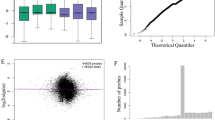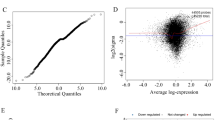Abstract
Perfluorooctane sulfonate (PFOS) and perfluorooctanoic acid (PFOA) represent a rising class of persistent organic pollutants termed perfluorinated chemicals (PFCs). In this study, hepatotoxic effects of PFCs were examined by microarray and gene ontology (GO) analysis. Human hepatocellular carcinoma (HepG2) cells were exposed to PFOS and PFOA for 48 h, and the RNA was collected. Global gene expression analysis using microarrays revealed 279 and 1,973 genes that changed greater than 1.5-fold after PFOS and PFOA exposure, respectively (P<0.05 for both), with 154 genes common to both PFCs. These genes were enriched in gene ontology (GO) terms and KEGG pathways associated with hepatotoxicity. Many genes were involved in complement and coagulation cascades, PPAR signaling pathway, and regulation of cell proliferation, which coincide with clinical evidence and indicate the critical hepatotoxicity of PFCs. These results show that transcriptome alterations induced by PFOS and PFOA could be possible signatures of the hepatotoxic effects of PFCs.
Similar content being viewed by others
References
Bjorklund, J. A., Thuresson, K. & De Wit, C. A. Perfluoroalkyl compounds (PFCs) in indoor dust: Concen-trations, human exposure estimates, and sources. Environ. Sci. Tech. 43, 2276–2281 (2009).
Fromme, H. et al. Perfluorinated compounds-Exposure assessment for the general population in western countries. Int. J. Hyg. Environ. Health 212, 239–270 (2009).
EPA. Revised draft hazard assessment of perfluorooctanoic acid and its salts. US Environmental Protection Agency. Office of Pollution Prevention and Toxics. Risk Assessment Division (AR226-1136), Washington, DC, p107 (2002).
Giesy, J. P. & Kannan, K. Global distribution of perfluorooctane sulfonate in wildlife. Environ. Sci. Technol. 35, 1339–1342 (2001).
Olsen, G. W. et al. Historical comparison of perfluorooctanesulfonate, perfluorooctanoate, and other fluorochemicals in human blood. Environ. Health Perspect. 113, 539–545 (2005).
Lindstrom, A. B., Strynar, M. J. & Libelo, E. L. Polyfluorinated compounds: past, present, and future. Environ. Sci. Technol. 45, 7954–7961 (2011).
Zhao, Y. G., Wong, C. K. & Wong, M. H. Environmental contamination, human exposure and body loadings of perfluorooctane sulfonate (PFOS), focusing on Asian countries. Chemosphere 89, 355–368 (2012).
D’Hollander, W., De Voogt, P., De Coen, W. & Bervoets, L. Perfluorinated substances in human food and other sources of human exposure. Rev. Environ. Contam. Toxicol. 208, 179–215 (2010).
Goosey, E. & Harrad, S. Perfluoroalkyl compounds in dust from Asian, Australian, European, and North American homes and UK cars, classrooms, and offices. Environ. Int. 37, 86–92 (2011).
Kim, S. K. et al. Distribution of perfluorochemicals between sera and milk from the same mothers and implications for prenatal and postnatal exposures. Environ. Pollut. 159, 169–174 (2011).
Andersen, M. E. et al. Perfluoroalkyl acids and related chemistries-toxicokinetics and modes of action. Toxicol. Sci. 102, 3–14 (2008).
Kennedy, G. L. et al. The toxicology of perfluorooctanoate. Crit. Rev. Toxicol. 34, 351–384 (2004).
Lau, C. et al. Seed Perfluoroalkyl acids: a review of monitoring and toxicological findings. Toxicol. Sci. 99, 366–394 (2007).
Abdellatif, A. et al. Peroxisomal enzymes and 8-hydroxydeoxyguanosine in rat liver treated with perfluorooctanoic acid. Dis. Markers 19, 19–25 (2003).
OECD (Organisation for Economic Co-operation and Development), ENV/JM/RD (2002)17/FINAL. Hazard assessment of perfluooroctane sulfonate (PFOS) and its salts (2002).
Kudo, N. & Kawashima, Y. Toxicity and toxicokinetics of perfluorooctanoic acid in humans and animals. J. Toxicol. Sci. 28, 49–57 (2003).
Son, H. Y. et al. Perfluorooctanoic acid-induced hepatic toxicity following 21-day oral exposure in mice. Arch. Toxicol. 82, 239–246 (2008).
Cui, L. et al. Studies on the toxicological effects of PFOA and PFOS on rats using histological observation and chemical analysis. Arch. Environ. Con. Tox. 56 338–349 (2009).
Eldasher, L. M. et al. Hepatic and renal Bcrp transport er expression in mice treated with perfluorooctanoic acid. Toxicology 306, 108–113 (2013).
Abdellatif, A. G., Preat, V., Taper, H. S. & Roberfroid M. The modulation of rat liver carcinogenesis by per fluorooctanoic acid. a peroxisome proliferator. Toxicol Appl. Pharmacol. 111, 530–537 (1991).
Beach, S. A., Newsted, J. L., Coady, K. & Giesy, J.P Ecotoxicological evaluation of perfluorooctane sulfon ate (PFOS). Rev. Environ. Contam. Toxicol. 186, 133–174 (2006).
Giesy, J. P. et al. Aquatic toxicology of perfluorinated chemicals. Crit. Rev. Env. Toxicol. 202, 1–52 (2009).
LeCluyse, E. L., Bullock, P. L. & Parkinson, A. Strate gies for restoration and maintenance of normal hepatic structure and function in long-term cultures of ra hepatocytes. Adv. Drug Deliver. Rev. 22, 133–186 (1996).
DelRaso, N. J. In vitro methodologies for enhanced toxicity testing. Toxicol. Lett. 68, 91–99 (1993).
“Existing Non-animal Alternatives”. Source: AltTox org.2011, 34–35 (2011).
Ding, G. H. et al. Acute toxicity of poly-and perfluori nated compounds to two cladocerans, Daphnia magna and Chydorus sphaericus. Environ. Toxicol. Chem. 31 605–610 (2012).
Ji, K. et al. Toxicity of perfluorooctane sulfonic acid and perfluorooctanoic acid on freshwater macroinver tebrates (Daphnia magna and Moina macrocopa) and fish (Oryzias latipes). Environ. Toxicol. Chem. 27 2159–2168 (2008).
Li, M. H. Toxicity of perfluorooctane sulfonate and perfluorooctanoic acid to plants and aquatic inverte brates. Environ. Toxicol. 24, 95–101 (2009).
MacDonald, M. M. Toxicity of perfluorooctane sulfon ic acid and perfluorooctanoic acid to Chironomus ten tans. Environ. Toxicol. Chem. 23, 2116–2123 (2004).
Song, M. K., Choi, H. S., Park, Y. K. & Ryu, J. C. Dis covery of characteristic molecular signatures for the simultaneous prediction and detection of environmen tal pollutants. Environ. Sci. Pollut. Res. 21, 3104–3115 (2014).
Song, M. K., Choi, H. S., Lee, H. S. & Ryu, J. C. Tran scriptome profile analysis of saturated aliphatic alde hydes reveals carbon number-specific molecules invo lved in pulmonary toxicity. Chem. Res. Toxicol. 27 1362–1370 (2014).
Mathijs, K. et al. Gene expression profiling in primary mouse hepatocytes discriminates true from false-posi tive genotoxic compounds. Mutagenesis 25, 561–568 (2010).
Van Kesteren, P. C. et al. Deregulation of cancer-relat ed pathways in primary hepatocytes derived from DNA repair-deficient Xpa-/-p53+/-mice upon exposure to benzo[a]pyrene. Toxicol. Sci. 123, 123–132 (2011).
Galbiati, V. et al. Establishment of an in vitro photoallergy test using NCTC2544 cells and IL-18 production. Toxicol. I. Vitro 27, 103–110 (2013).
Van der Veen, J. W., Pronk, T. E., van Loveren, H. & Ezendam, J. Applicability of a keratinocyte gene signature to predict skin sensitizing potential. Toxicol. I. Vitro 27, 314–322 (2013).
Vandebriel. R. J. et al. Keratinocyte gene expression profiles discriminate sensitizing and irritating compounds. Toxicol. Sci. 117, 81–89 (2010).
Verstraelen, S. et al. Gene profiles of a human bronchial epithelial cell line after in vitro exposure to respiratory (non-)sensitizing chemicals: identification of discriminating genetic markers and pathway analysis. Toxicology 255, 151–159 (2009).
King, K. L. & Cidlowski, J. A. Cell cycle regulation and apoptosis. Annu. Rev. Physiol. 60, 601–617 (1998).
Kerr, J. F. & Searle, J. A mode of cell loss in malignant neoplasms. J. Pathol. 106, Pxi (1972).
Michalik, L., Desvergne, B. & Wahli, W. Peroxisomeproliferatoractivated receptors and cancers: complex stories. Nat. Rev. Cancer 4, 61–70 (2004).
Tachibana, K., Yamasaki, D., Ishimoto, K. & Doi, T. The role of PPARs in cancer. PPAR. Res. 2008, Article ID 102737 (2008).
Reddy, J. K., Azarnoff, D. L. & Hignite, C. E. Hypolipidaemic hepatic peroxisome proliferators form a novel class of chemical carcinogens. Nature 283, 397–398 (1980).
Peters, J. M., Cattley, R. C. & Gonzalez, F. J. Role of PPARa in the mechanism of action of the nongenotoxic carcinogen and peroxisome proliferator Wy-14,643. Carcinogenesis 18, 2029–2033 (1997).
Hays, T. et al. Role of peroxisome proliferator-activated receptor-a (PPARa) in bezafibrate-induced hepatocarcinogenesis and cholestasis. Carcinogenesis 26, 219–227 (2005).
Gervois, P. et al. Global suppression of IL-6-induced acute phase response gene expression after in vivo chronic treatment with the peroxisome proliferator-activated receptor a activator fenofibrate. J. Biol. Chem. 279, 16154–16160 (2004).
Hellemans, K. et al. Peroxisome proliferator-activated receptor-beta signaling contributes to enhanced proliferation of hepatic stellate cells. Gastroenterology 124, 184–201 (2003).
Shan, W. et al. Peroxisome proliferator-activated receptorbeta/delta protects against chemically induced liver toxicity in mice. Hepatology 47, 225–235 (2008).
Hood, E. Alternative Mechanism for PFOA?: Trout Studies Shed Light on Liver Effects. Environ. Healt. Perspect. 116, A351 (2008).
DeWitt, J. C. et al. Immunotoxicity of perfluorooctanoic acid and perfluorooctane sulfonate and the role of peroxisome proliferator-activated receptor alpha. Crit. Rev. Toxicol. 39, 76–94 (2009).
Rosen, M. B. et al. Gene expression profiling in the liver and lung of perfluorooctane sulfonate-exposed mouse fetuses: comparison to changes induced by exposure to perfluorooctanoic acid. Reprod. Toxicol. 27, 278–288 (2009).
Corton, J. C. in Cancer risk assessment: chemical carcinogenesis, hazard evaluation, and risk quantification (eds Hsu, C.-H., Stedeford, T.) 438-481 (John Wiley & Sons, Inc, New Jersey, Hoboken, 2010).
Klaunig, J. E. et al. PPARa agonist-induced rodent tumors: modes of action and human relevance. Crit. Rev. Toxicol. 33, 655–780 (2003).
Foreman, J. E. et al. Differential hepatic effects of perfluorobutyrate mediated by mouse and human PPARalpha. Toxicol. Sci. 110, 204–211 (2009).
EPA, https://peerreview.versar.com/epa/pfoa/pdf/Health-Effects-Document-for-Perfluorooctane-Sulfonate-(PFOS).pdf (2014).
Mosmann, T. Rapid colorimetric assay for cellular growth and survival: Application to proliferation and cytotoxicity assays. J. Immunol. Methods 65, 55–63 (1983).
Park, Y. S. et al. Identification of three novel mutations in Korean phenylketonuria patients: R53H, N207D, and Y325X. Hum. Mut. Suppl. 1, S121–122 (1998).
Benjamini, Y. & Hochberg, Y. Controlling the false discovery rate-A practical and powerful approach to multiple testing. J. Roy. Stat. Soc. Met. 57, 289–300 (1995).
Author information
Authors and Affiliations
Corresponding author
Electronic supplementary material
Rights and permissions
About this article
Cite this article
Song, MK., Cho, Y., Jeong, SC. et al. Analysis of gene expression changes in relation to hepatotoxicity induced by perfluorinated chemicals in a human hepatoma cell line. Toxicol. Environ. Health Sci. 8, 114–127 (2016). https://doi.org/10.1007/s13530-016-0269-x
Received:
Revised:
Accepted:
Published:
Issue Date:
DOI: https://doi.org/10.1007/s13530-016-0269-x




